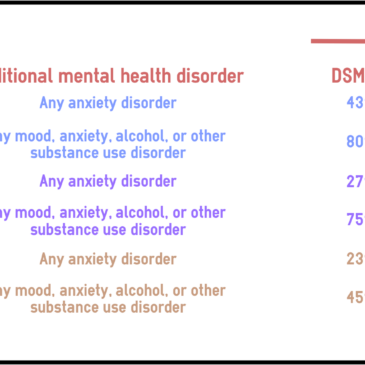Many people experiencing gambling disorder also experience at least one other mental health disorder. When the American Psychiatric Association most recently revised its diagnostic guidelines (creating the DSM-5), it reduced the number of symptoms required for a diagnosis of Gambling Disorder (GD) from 5 of 10 criteria to 4 of 9 criteria. This change will expand the pool of people eligible to be diagnosed with GD, and some of those who are newly eligible for a GD diagnosis might also experience other mental health disorders. This week, The WAGER reviews a study by Ryan Nicholson and colleagues that explored the implications of this new diagnostic threshold for the prevalence of mental health disorders among people experiencing GD.
What is the research question?
Does changing the diagnostic threshold for GD change the prevalence of co-occurring mental health/substance use disorders?
What did the researchers do?
The researchers analyzed data from the 2001-2002 National Epidemiologic Survey on Alcohol and Related Conditions. Participants completed a checklist assessing gambling problems. From these responses, the researchers created lists of individuals who met the old and new diagnostic thresholds for GD. Participants then completed the AUDADIS-IV, a survey designed to assess experiences of substance use disorder and mental disorders.
What did they find?
When the researchers applied the DSM-5 threshold, more participants qualified for GD (135 under the DSM-5 threshold, compared to 77 under the DSM-IV threshold). However, the prevalence of co-occurring mental health/substance use disorders was the same in both groups, considering participants overall. When the researchers divided participants into age groups, they found that adults 55 and older who qualified for GD under DSM-5 were more likely to report certain co-occurring conditions compared to those who qualified under DSM-IV (see figure).
 Figure. A comparison of the prevalence of an additional mental health/substance use disorder among people diagnosed with GD under DSM-IV versus DSM-5 thresholds. Asterisks represent higher prevalence of the co-occurring mental health/substance use disorder among the DSM-5 group. Percentages are rounded to the nearest whole number. Click image to enlarge.
Figure. A comparison of the prevalence of an additional mental health/substance use disorder among people diagnosed with GD under DSM-IV versus DSM-5 thresholds. Asterisks represent higher prevalence of the co-occurring mental health/substance use disorder among the DSM-5 group. Percentages are rounded to the nearest whole number. Click image to enlarge.
Why do these findings matter?
Older adults who report gambling problems should also be screened for co-occurring mental health and substance use problems.
Every study has limitations. What were the limitations in this study?
This survey was conducted over a decade ago, so we do not know if people experiencing gambling and other mental health problems experience these problems at the same rates. The researchers only looked at experiences of mental disorders in the past year. It is unclear whether or not lifetime experiences of mental health disorders are higher than past year reports.
For more information:
If you think that you or anyone you know might be experiencing substance use or gambling-related problems, you can find help resources on the BASIS addiction resources page.
— Pat Williams
What do you think? Please use the comment link below to provide feedback on this article.




